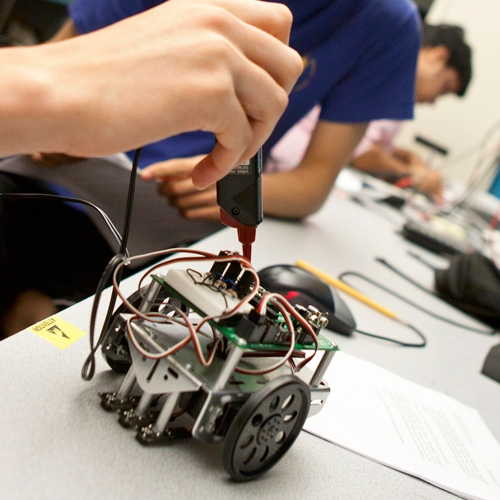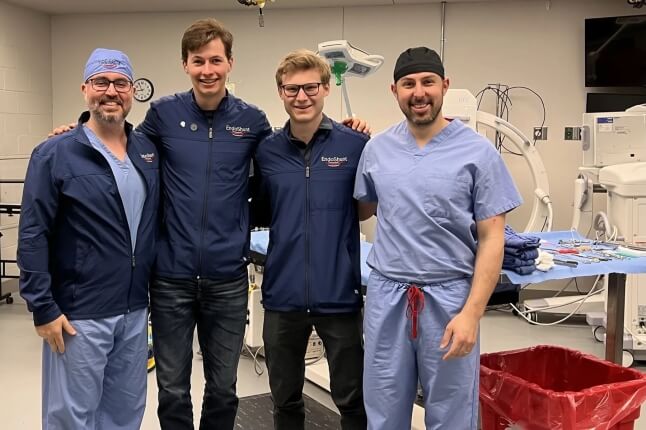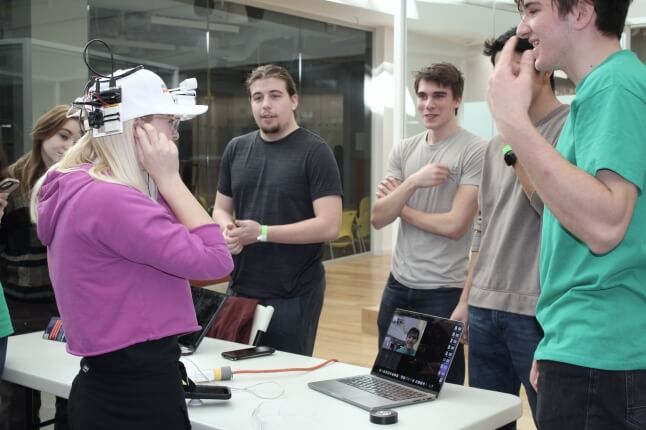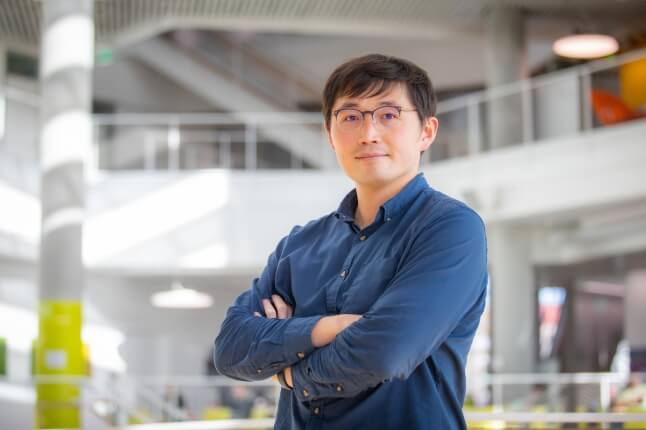News
The aim with the new Electrical Engineering and Mechanical Engineering degree programs is to broaden technical offerings while staying true to the liberal arts core.
Harvard College students will now be able to pursue stand-alone S.B. degree programs in Electrical Engineering and Mechanical Engineering at the Harvard School of Engineering and Applied Sciences (SEAS).
The programs, which will debut in the Fall of 2012, were unanimously approved at the May 1 Faculty Meeting of the Faculty of Arts and Sciences (FAS).
SEAS currently offers A.B. and S.B. degrees in Engineering Sciences.The A.B. in Engineering Sciences requires 14–16 courses, while the S.B.degree requires 20 courses. The S.B. degree is ABET-accredited and it is currently the only S.B. degree at Harvard.
SEAS plans to seek ABET accreditation for both S.B. degrees in Electrical Engineering and Mechanical Engineering in the coming years. (ABET provides specialized, programmatic accreditation that evaluates an individual program of study, rather than evaluating an institution as a whole. Harvard first received ABET accreditation in 1962 for Engineering Sciences.)
With the newly created Biomedical Engineering concentration already in place and new Electrical Engineering and Mechanical Engineering concentrations approved, the existing Engineering Sciences concentration (which allows students to specialize in one of several tracks) will evolve, de-emphasizing separate tracks in favor of a highly interdisciplinary integrative program that the Engineering Sciences concentration is ideally suited to provide.
Frequently Asked Questions
What is the rationale for the new degree programs?
We have singular advantages in defining new Electrical Engineering and Mechanical Engineering concentrations that are relevant to today’s students and today’s challenges. Moreover, both degree programs are standard at peer institutions, and our own students and faculty have voiced significant and growing interest in developing stand-alone S.B. degree programs. The aim is to broaden our technical offerings while staying true to our liberal-arts core.
A focused Electrical Engineering degree will help provide our students with a solid grounding in fundamental scientific and engineering principles and allow them to hone life-long skills in questioning, analyzing, and developing solutions to all of the challenges that they and the world will face. Likewise, the S.B. degree in Mechanical Engineering, a field that underlies almost all advances in engineering and science, addresses an clear desire voiced by our students and faculty.
Both degrees will require 20 courses and will provide in-depth study on a broad scope of topics. The new degrees are positioned to become robust concentrations from their inception. Roughly one-fifth of our current Engineering Sciences concentrators will likely switch to the Electrical Engineering concentration once it is available, and nearly half of our current Engineering Science concentrators are already pursuing the Mechanical and Material Science and Engineering track. Further, we plan to seek ABET accreditation for both S.B. degrees in Electrical Engineering and Mechanical Engineering in the coming years. (See above for an explanation of ABET.)
Engineering has evolved more deeply into specific fields, while continuing to seek out solutions to real-world problems by combining concepts from a broad range of scientific inquiry and innovation. With the future Electrical Engineering and Mechanical Engineering concentrations, we aim to modify the existing Engineering Sciences concentration to be broader and more flexible. The revised program will provide a flexible framework that allows students to assemble a set of courses that better accommodate interdisciplinary study and interests, while still maintaining a close connection to the broader liberal-arts experience.
What are SEAS’ plans for advising?
We believe there are several components to advising: (i) helping students understand the different SEAS concentrations and requirements, and providing guidance at the time of declaring a concentration; (ii) offering guidance through the concentration; and (iii) helping students who wish to move between concentrations.
As the number of concentrators in Engineering Sciences (and in SEAS overall) continues to grow, we have plans (some already in place) for a solid support structure to ensure thorough student advising through the newly proposed and existing concentrations. Advising will rely heavily upon Directors of Undergraduate Studies, Assistant Directors of Undergraduate Studies, and the broader faculty.
- Each concentration has a Director of Undergraduate Studies who plays a leading role in student advising. Due to the broad scope of the current Engineering Sciences concentration, we also have consulting directors for the mechanical, environmental, and biological engineering tracks within Engineering Sciences. The Directors of Undergraduate Studies for Engineering Sciences are currently both from Electrical Engineering.
- Directors of Undergraduate Studies are usually senior ladder faculty (with some exceptions).
- We also have Assistant Directors of Undergraduate Studies, whose primary role is student advising, but who also teach intro-level courses. SEAS currently has two wonderful Assistant Directors in Applied Math and Biomedical Engineering. We have three searches in process for Assistant Directors in Mechanical Engineering, Environmental Engineering, and broad engineering (with focus toward Electrical Engineering).
- The Assistant Directors of Undergraduate Studies will be at the forefront of advising students to help them navigate through the different concentrations, course requirements, internship opportunities, career advising, and so forth. However, we also fully expect faculty advisers who are assigned to students to provide additional focused advising.
- With the introduction of new concentrations in Electrical Engineering and Mechanical Engineering, we plan to appoint Directors of Undergraduate Studies in Electrical Engineering, Mechanical Engineering, and Engineering Sciences. These three Directors will be able to provide better-focused advising to students interested in specific areas of engineering, which is currently lacking. For example, the Directors can better match incoming concentrators with faculty advisers.
- Two SEAS committees are in place to set high-level guidelines on concentrations and advising. The Engineering Sciences Committee on Undergraduate Education oversees Engineering Sciences specifically. Another broader committee on undergraduate education at SEAS coordinates activities across all concentrations (Applied Mathematics, Computer Science, and Engineering Sciences). These committees largely consist of the Directors of Undergraduate Studies, consulting Directors, Assistant Directors, and staff from the SEAS Student Affairs Office.
Declaring a concentration
The Assistant Dean for Academic Programs at SEAS, Marie Dahleh, coordinates much of the preconcentration activities. She works with the Student Affairs staff, Directors of Undergraduate Studies, and Assistant Directors of Undergraduate Studies to ensure that SEAS has a solid presence in the numerous Harvard College advising fairs (e.g., before fall term and Advising Fortnight). In recent years, we’ve been able to enhance faculty involvement in these activities.
The Directors of Undergraduate Studies and Assistant Directors will play a critical role in fielding questions from prospective concentrators such as: the differences between A.B. and S.B. degrees; the differences between Electrical Engineering, Mechanical Engineering, and Engineering Sciences concentrations; Math and Science (i.e., Physics) preparations; etc.
Guidance through the concentration
Once students have declared a concentration, the Directors of Undergraduate Studies and Assistant Directors of Undergraduate Studies will match each concentrator with an appropriate faculty adviser. Faculty advisers will provide broad advising in terms of course selection and understanding of what the concentration entails.
The Directors of Undergraduate Studies and Assistant Directors of Undergraduate Studies will provide more detailed advising in terms of course requirements and procedures. They will also be at the front lines to raise potential issues to the broader faculty. For example, as the newly proposed Electrical Engineering and Mechanical Engineering concentrations seek out ABET accreditation, there may be several issues that arise in regard to what meets or does not meet the requirements.
Guidance between concentrations
We expect students will want to move between concentrations throughout their time in college, either between the A.B. and S.B. degrees or even between Electrical Engineering, Mechanical Engineering, and Engineering Sciences concentrations. Again, the Directors of Undergraduate Studies and Assistant Directors of Undergraduate Studies will be vital in helping students understand the differences and navigate through their options. We will have written guidelines (posted online) to clearly explain the options and provide suggestions.
How do we plan to attract students to the Engineering Sciences, Mechanical Engineering, and Electrical Engineering concentrations?
In some sense, our current numbers speak for themselves. We’ve seen a sizable increase in enrollments for our introductory courses, namely CS 50, ES 50, and ES 51. This academic year, we had to offer ES 51 twice. ES 50 enrollment has nearly doubled from ~40 students last year to over 70 students this year.
In addition to focused advising and availability of information and advisers for prospective concentrators, we will continue to offer exciting introductory courses and leverage them as gateways to these new concentrations. This approach has been highly successful for the Computer Science concentration that has seen a dramatic increase in numbers. Also worthy of note, Harvard boasts one of the best female/male ratios (~40%) in Computer Science compared to the national average, which is closer to 10%.
Both of our current Assistant Directors of Undergraduate Studies are women, and we believe this has helped to provide good role models for our students and educate them on the opportunities for women in engineering.
How do Electrical Engineering, Mechanical Engineering, and Engineering Sciences fit into Harvard’s liberal-arts education?
Engineering is one of several gateways to quantitative and analytical thinking, and it is not just a collection of facts or concepts. Engineering offers interesting and exciting opportunities for students to identify problems in the world around them, seek out innovative solutions, and verify the feasibility and quality of these solutions through a rigorous blend of theory and experimentation.
Why is there no proposal for an A.B. in Electrical Engineering and Mechanical Engineering?
At this time, SEAS feels that it is important to offer S.B. degrees in Electrical Engineering and Mechanical Engineering with ABET accreditation. The current A.B. degree in Engineering Sciences offers more flexibility for students to navigate through the various engineering disciplines. We’ve also seen a trend towards more S.B. concentrators.
What are our plans for existing Engineering Sciences concentrators who are interested in switching over to the new concentrations?
We hope that many of our current Engineering Sciences concentrators will be able to switch over to the new Electrical Engineering and Mechanical Engineering concentrations. Currently, Engineering Sciences concentrators in the Mechanical Engineering track ought to be able to switch over with one additional course. We may be able to make exceptions in the first couple of years.
Engineering Sciences concentrators in the Electrical Engineering track also ought to be able to switch over with little trouble.
It will be important for students to understand that our current S.B. in Engineering Sciences is ABET-accredited, but the new Electrical Engineering and Mechanical Engineering S.B. degrees will not have accreditation for a number of years (~4 years) since ABET requires us to have graduated students prior to seeking accreditation.
What is ABET and why is it important to SEAS?
ABET is a nonprofit, nongovernmental organization that accredits college and university programs in the disciplines of applied science, computing, engineering, and engineering technology. ABET accredits over 3,100 programs at more than 660 colleges and universities in 23 countries. ABET provides specialized, programmatic accreditation that evaluates an individual program of study, rather than evaluating an institution as a whole. Harvard first received ABET accreditation in 1962 for Engineering Sciences.
ABET reviews programs every 6 years. The last general review was in 2009. We had an interim review in 2011 to verify that SEAS addressed several concerns raised by ABET's visiting committee in 2009. The 2011 interim review went well and all major issues were resolved.
ABET rules require 1 year of math and science (8 half-courses) and 1.5 years of engineering courses (12 half-courses). All accredited degrees must meet general engineering rules plus discipline-specific rules. For Electrical Engineering, additional requirements are specified by the Institute of Electrical and Electronics Engineers (IEEE). For Mechanical Engineering, additional requirements are specified by the American Society of Mechanical Engineers (ASME). The SEAS website specifies ABET (a)–(k) objectives and outcomes in accordance with ABET rules and accreditation requirements.
An ABET accredited degree is required for graduates to seek licensure and become professional engineers in the United States. This is akin to the licensing associated with medicine and law.
Nationally, ~65% of mechanical engineers seek licensure. At SEAS, we have seen two students per year seeking licensure in recent years.
Topics: Electrical Engineering
Cutting-edge science delivered direct to your inbox.
Join the Harvard SEAS mailing list.



